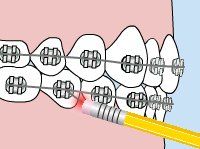Orthodontic Retention
Orthodontic Retention
You've worked hard for your beautiful smile; keep it that way!
Finally, your braces have been removed and your smile is beautiful, straight, and best of all, metal-free! However, your orthodontic journey isn't quite completed. To keep your smile looking its best, you'll have to wear a retainer to preserve and stabilize your results. Retainers are needed to control or limit potential changes in tooth position. They are used after braces treatment to hold teeth in their correct alignment while the surrounding gums, bone, and muscle adjust to the new positioning of your teeth.
Types of Retainers
Retainers are custom-made and can be removable or fixed.
- Traditional removable retainers typically include a metal wire that surrounds the front teeth and is attached to an acrylic arch that sits in the roof of the mouth. The metal wires can be adjusted to finish treatment and continue minor movement of the front teeth as needed.
- Aligner-style retainers, or Essix retainers, look similar to clear aligners and offer a more aesthetic alternative to wire retainers. This clear retainer may fit over the entire arch of your teeth, or only from canine to canine (clip-on retainer). It is produced from a mold of your newly aligned teeth.
- Fixed retainers consist of wires bonded behind the bottom and/or top teeth. While the device is usually required no more than a year after wisdom teeth have been extracted, it is often kept in place for life.
Pros and Cons
- Removable retainers can be taken out for eating and hygiene routines.
- Removable retainers can get lost easily, so remember to keep yours in the case whenever you remove it to eat or brush.
- A fixed retainer is great if you don't want to keep track of it, or if you don't want to worry about how many hours per day it must be worn.
- Teeth with fixed retainers require a little extra attention to remove tartar while flossing. Patients with fixed retainers often must use floss threaders to pass dental floss through the small spaces between the retainer and the teeth.
What can I do to relieve discomfort caused by my TAD?
If you do feel any discomfort from having your TADs placed, Tylenol® is recommended to help relieve your pain. If you continue to experience discomfort days after your treatment, please contact your dentist as soon as possible.
How can I keep my TAD clean?
A TAD can be cleaned the same way you clean your braces: by brushing your teeth at least three times a day. When your TAD is placed, we will also provide you with an antimicrobial mouthwash that you will need to use twice a day.
If you have questions about TADs, please contact our practice. We will be able to answer any of your questions and provide you with detailed information about your orthodontic treatment.

General Soreness
When you get your braces on, you may feel general soreness in your mouth, and teeth may be tender to biting pressures for three to five days. Stick to a soft diet until your teeth do not hurt to chew. Irritated gums and other sore spots can be relieved by rinsing your mouth with a warm salt-water mouthwash. Dissolve one teaspoonful of salt in eight ounces of warm water, and rinse your mouth vigorously. If the tenderness is severe, take Acetaminophen (Tylenol) or whatever you normally take for headache or similar pain. Aspirin, Ibuprofen (Motrin, Advil) and Naproxen Sodium (Naprosyn, Anaprox) actually slow the tooth movement, so it is not advisable to use them frequently while wearing braces.
The lips, cheeks, and tongue may become irritated for one to two weeks as they learn a new posture and become accustomed to the surface of the braces. You can put wax on the braces to lessen this. We'll show you how!
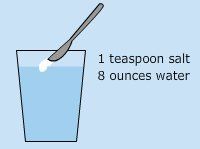
Headgear
Sometimes discomfort is caused by not wearing the headgear as instructed by your orthodontist. Please refer to the instructions provided by your orthodontist. If the facebow (metal piece) is bent, please call our office for assistance. The headgear should hurt less the more it's worn, so be sure you get in the prescribed number of hours.
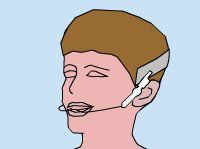
Loose Appliance
If your appliance is poking you, place wax on the offending part.
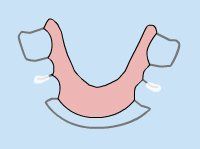
Loose Bracket
If your bracket or band is still attached to the wire, you should leave it in place and put wax on it if needed for comfort. If the bracket or band can be removed easily, place it in an envelope and save it to bring to your next appointment.
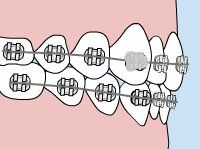
Loose Wire
Using a pair of tweezers or needle-nosed pliers, try to put your wire back into place. It is okay to use a piece of floss to tie the wire into place: tie the floss around the bracket in place of the missing colored o-ring. If you cannot put the wire into a comfortable position, and covering the end with wax doesn't help, as a last resort use a small fingernail clipper to clip the wire behind the last tooth to which it is securely fastened. If the end of the wire is still sharp place wax on it.
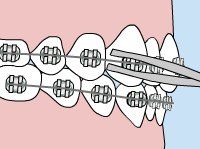
Poking Wire
Using a pencil eraser, push the poking wire down or place wax on it so that it is no longer poking.
